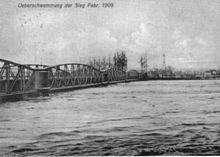Victory flood 1909


The victory flood in 1909 in February was the highest of the many floods in Sieg , at the same time there were also flood alarms in many other regions of Germany. Extensive rainfalls, coupled with rapid snowmelt and unfavorable weather conditions, were considered the trigger.
Description of the damage
According to a report in the Eitorfer Zeitung, all bridges in the municipality of Herchen , with the exception of those at Haus Dernburg , were torn away by the flood. This affected the bridges in Röcklingen , Herchen, the railway bridge shown and the bridges in Stromberg and Troisdorf.
In Eitorf-Merten, a pillar of the railway bridge on the Sieg line was washed away so that the tracks sank. In Hennef, a flock of 600 sheep was trapped by the water, 150 of which were rescued by the fire brigade and courageous citizens.
In Siegburg, according to a picture taken by the photographer Eduard Dickopf, the Siegwasser stood except for Frankfurter Strasse (formerly B8 ).
Individual evidence
- ^ W. Gerbing: The flood of February 1909; Pp. 457 and 458. Zentralblatt der Bauverwaltung, August 24, 1909, accessed on September 13, 2019 .
- ↑ Andrea Korte-Böger: Siegburger Blätter Land under , Vol. 24
- ↑ Herbert Weffer: From Siegburg to Windeck , the Rhein-Sieg district on the right bank of the Rhine in old postcards, Bouvier Verlag Bonn, 2002, ISBN 3-416-02996-8